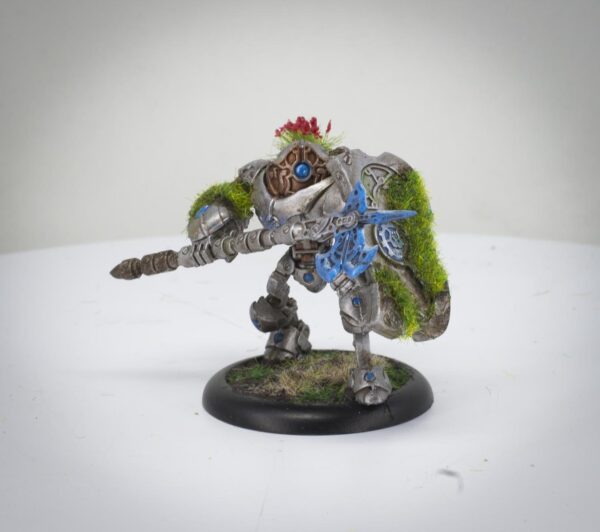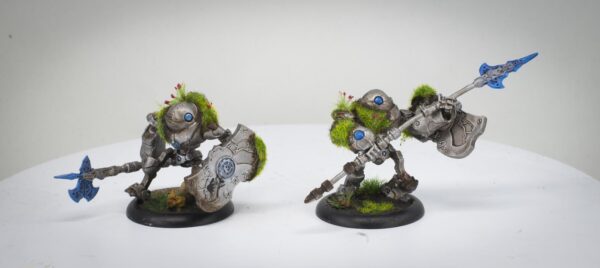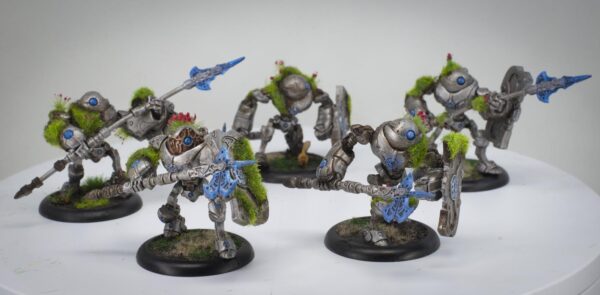
Grass on Steel: Charles DeYoung’s Convergence of Cyriss
Hello friends, family, and all you mad sea captains out there. My name is Charles DeYoung, and today I want to talk about my new love affair with Convergence of Cyriss. In today’s Insider, I’m going to discuss hobbying from a newcomer’s perspective this compelling army.
First, a little about myself: I joined the Privateer team several months back, right before our big move to the new headquarters, a monumental undertaking I participated in. I work in our casting facility in the morning and our packing facility in the afternoon. Our departments aren’t big, but we’re staffed with great people and we work harder than Christmas elves to get you your favorite toys.
There’s a company-wide Oblivion campaign and slow-grow league going on right now at Privateer Press; you may have noticed our streams, posts, and various social media content around it. Because I was a newcomer to the company and to WARMACHINE and HORDES, I was naturally excited to participate. This is when a co-worker suggested I look into the Convergence of Cyriss.
It immediately reminded me of Fritz Lang’s 1927 film Metropolis with its clockwork angels and art deco—cogwork hybridized warjacks. The Enigma Foundry, for example, has to be one of my all-time favorite miniatures in both my collection and in play. It is also one of the miniatures in this range that I believe most strongly personifies these stylistic elements.
From a hobbying standpoint, the army presents some unique challenges as well as numerous opportunities for a lot of fun and creativity. While conceptualizing this project, our studio painter Jordan Lamb gave me some wonderful inspiration: we spoke about the robots featured in the 1986 Studio Ghibli film Laputa Castle in the Sky by Hayao Miyazaki. They were overgrown with moss, plants, and flowers as a result of standing immobile for centuries.
When I got home that same night, I immediately began shopping for flock and other basing materials to cover my miniatures in and started planning my build. I want to walk you through my process and what I’ve learned so far while building, painting, and playing with the Convergence of Cyriss.
Privateer Press has been in business for 20 years, and the Convergence was released back in 2013, which means the range has had seven years to grow (albeit slowly) with new releases and updates. During that time, methods of manufacturing have changed, and as a result, we have four materials to work with: spun metal, cast resin, and two types of plastic. Each behaves in a slightly different manner and nailing a few basic principles will expedite your builds.
First, for spun metal I find that during the assembly phase, metal components have more weight to them and at times have small contact points. Maintain pressure on these points and blow on them for a bit longer than any other components. You can also build up layers of glue around these contact points with a probe to further secure them, or if worse comes to worst, you can always resort to pinning.
Cast resin will always contain some excess material at its injection points. When the models are excavated from their molds, they’re trimmed, but to prevent damaging the model, a small part of the vent may remain. You can use a pair of flush cutters and a hobby knife to remove this part and ensure a smooth finish. Fortunately, the material is fairly soft and easy to cut.
Finally, both types of plastics tend to be in multi-part kits. This allows some pose-ability with the models: the sprues and components were easy to cut and position. If you find a component has any warping, or if you don’t particularly like the pose, warm the component up with hot water or a hair dryer to easily adjust the plastic.
Painting is also fun and easy! For beginners, the army could be done in a few coats of metallic primer, edge highlighted with Quicksilver and Arcane Blue for the lenses. I started layering up my metallics as if I were working on a normal Convergence model then turned around to add grime and weathering to my heart’s content. The process is a bit more time consuming but a lot of fun. I was able to create a lot of cool effects by applying paint and wiping it away with my finger. I then took a small sculpting tool and carved into a glue stick, applying the glue directly to the miniature, and then affixing the flock to it; it was surprisingly easy, albeit messy.
I am also adding flowers and wildlife to the models and bases, again drawing inspiration from the robots in Laputa Castle in the Sky. I really like the aesthetic of these machines being in harmony with nature, having stood immobile for so long they may have become the unwitting home of a bird’s nest or a trove of nuts hoarded by a squirrel.
Playing the Oblivion campaign as someone new to WARMACHIND has been very fun, and I am about to participate in the fourth mission. As this will be my first game with a warcaster, it’ll be a trial by fire to playing WARMACHINE the way it’s meant to be played. With my prototype Reciprocators done, I am going to move on to confidently painting the rest of my force with the lessons I have learned. I have ten Reductors built, my Enigma Foundry, various priests, and six Clockwork Angels to paint.
Then, I just have to start building some Vectors…





